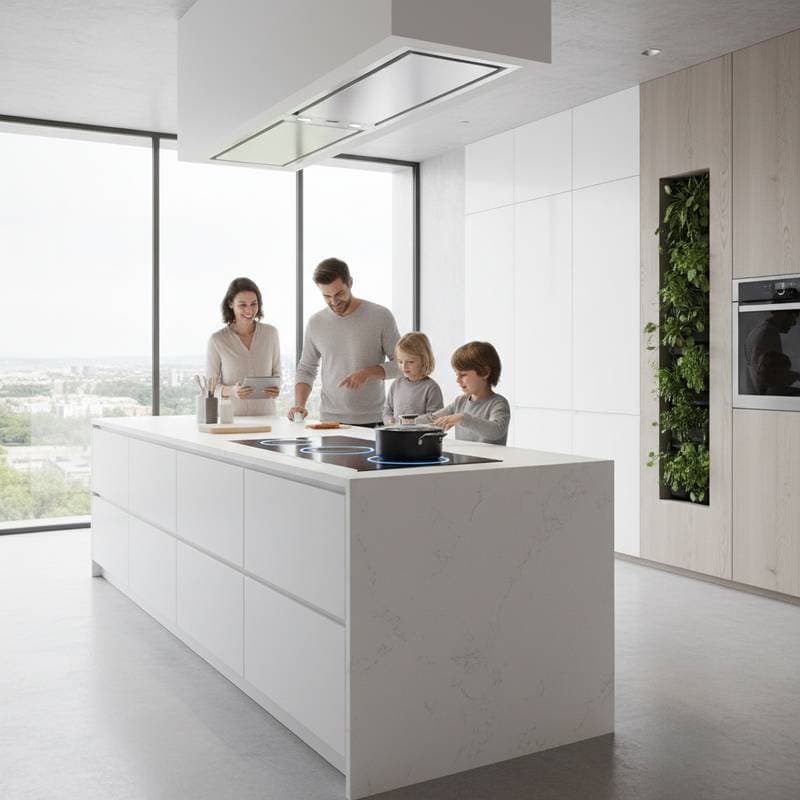Japandi Kitchens: The Shift from Stark White to Inviting Warmth
Homeowners often install all-white kitchens for their bright, spacious appeal. Over time, however, these spaces can appear lifeless and demanding to maintain. Designers increasingly advocate for Japandi kitchens, which fuse Japanese minimalism with Scandinavian functionality. This approach replaces uniform white surfaces with natural wood grains, layered textures, and harmonious neutrals to foster a more welcoming atmosphere.
The following sections explain the drawbacks of all-white designs and outline practical steps to adopt Japandi elements. These changes enhance both aesthetics and usability without requiring extensive renovations.
Reasons to Abandon All-White Kitchens
All-white kitchens evoke purity and modernity, yet they present challenges in daily use. White surfaces show dirt readily, and uniform tones create a flat visual field that lacks emotional resonance. Homeowners seek alternatives that introduce warmth and depth while preserving simplicity.
Consider these key factors driving the transition to wood-infused designs:
-
Enhanced Comfort and Natural Harmony
Organic wood tones evoke serenity and a bond with the environment. Such elements make the kitchen a refuge rather than a clinical zone. -
Simplified Upkeep
Wood finishes and muted colors conceal everyday marks better than pristine white. This reduces cleaning frequency and preserves the space's appeal. -
Added Visual Interest
The inherent patterns in oak or walnut provide subtle layers that white schemes cannot replicate. The result is a grounded, multidimensional room. -
Enduring Style
Natural materials evolve attractively with age. They resist dating as rapidly as stark white, ensuring long-term relevance.
Steps to Introduce Japandi into an Existing White Kitchen
A full overhaul is unnecessary to infuse Japandi warmth. Targeted updates can soften the palette and introduce texture progressively. Begin with assessments of current elements like cabinetry and lighting to prioritize impactful changes.
-
Refinish Cabinet Surfaces
Apply a light stain to existing cabinets for an oak or walnut effect. Professional services cost approximately 150 to 250 dollars per linear foot; DIY options range from 40 to 70 dollars per linear foot, including materials like sandpaper and sealant. -
Select Warmer Countertops
Opt for soapstone or honed marble over glossy quartz. Installation typically runs 70 to 120 dollars per square foot, delivering immediate tonal balance. -
Revamp the Backsplash
Install artisanal tiles in soft beige or sage hues instead of uniform white. Zellige or terracotta varieties add artisanal charm without overwhelming the space. -
Incorporate Wood Details
Add open shelves, a wooden island extension, or utensil holders crafted from reclaimed timber. These accents bridge the gap between minimalism and practicality. -
Optimize Lighting Choices
Switch to bulbs emitting warm white light at 2700 Kelvin. This adjustment casts a gentle glow that complements wood tones throughout the day. -
Streamline Accessories
Curate essentials only, favoring items in natural fibers or ceramics. This decluttering aligns with Japandi's emphasis on intentional sparsity.
Essential Guidelines for Japandi Harmony
Achieving Japandi requires precision to avoid a sparse appearance. Focus on cohesion and subtlety to elevate the design.
- Select wood varieties with consistent warm undertones, blending light ash with medium teak for varied depth.
- Prioritize matte or satin finishes on all surfaces to sustain the tranquil vibe.
- Install layered illumination, including overhead fixtures, task lights, and ambient sources, to adapt to cooking and gathering needs.
- Introduce live plants or foraged elements sparingly to echo nature's irregularity.
- Conceal hardware behind flat panels or integrate pulls seamlessly into cabinet faces.
- Embrace materials with organic imperfections, such as hand-thrown pottery or textured linens, for genuine character.
Pitfalls to Sidestep in Japandi Implementation
Even subtle errors can undermine the style's poise. Awareness of these issues ensures a refined outcome.
-
Blending Incompatible Elements
Japandi demands uniformity in restraint. Steer clear of elaborate moldings or metallic accents that clash with the serene foundation. -
Excessive Dark Contrasts
Limit black to functional points like a faucet or window frame. Overuse shifts the mood from balanced to severe. -
Neglecting Practical Storage
Ensure ample concealed drawers and pantry solutions match your routine. Form follows function in this philosophy. -
Incorporating Chilly Tones
Avoid blue-gray paints or LED lights with cool casts, as they counteract the inherent warmth. -
Settling for Artificial Substitutes
Genuine wood or stone outperforms faux versions in authenticity. Budget constraints favor veneers over low-grade laminates for believable texture.
Sustained Advantages of Japandi Design
Beyond initial appeal, Japandi kitchens nurture well-being through their thoughtful composition. Durable woods and neutrals withstand years of use, maintaining elegance without frequent updates. The design's reliance on timeless elements shields it from trend volatility.
Practical gains include reduced maintenance efforts and versatile lighting that enhances usability. During resale, such kitchens attract diverse buyers drawn to their adaptable, nature-inspired allure, safeguarding property value effectively.
Implementing Your Japandi Transformation
Embark on the shift by evaluating your kitchen's current shortcomings, such as overly bright reflections or insufficient texture. Introduce wood and warmth incrementally, testing changes for overall flow. Ultimately, this evolution crafts a space that aligns with daily rhythms, blending ease and elegance seamlessly.










